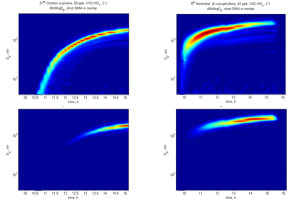The Manchester Aerosol Chamber - Precursor Selection
The selection of VOC precursors for chamber investigations and mechanism development studies must be guided by the atmospheric relevance of the VOC. For example, emitted speciation of biogenic VOC is highly complex, and published studies have typically reported up to ca. 20 species making notable contributions to monoterpene, sesquiterpene and oxygenated VOC fluxes from a variety of vegetation types at a variety of locations. Because of differences in structure and reactivity, these species are oxidised in the atmosphere on timescales ranging from minutes to days and possess a range of propensities to form SOA. For the funded Aerosol Coupling in the Earth System (ACES) chamber experimental programme, it was necessary to identify a practical subset series of biogenic VOC which can be used to represent the range of emitted species and the corresponding range in the rates and chemical complexity of their subsequent degradation. The available information on the atmospheric lifetimes of observed biogenic VOC with respect to reaction with OH radicals and O3, and current understanding on their known or probable degradation pathways, suggest that it is reasonable to divide the biogenic VOC into a series of structural subsets possessing similar characteristics. As a result, consideration of a single compound from each category provides a logical and defensible strategy for significantly simplifying the emitted speciation whilst maintaining the range in oxidation timescales and propensities to generate SOA. The table provides a summary of the categories, identifying possible representatives and their atmospheric lifetimes with respect to reaction with OH and O3 at typical concentrations. The identified species thus provide a plausible initial reduced set of compounds for consideration for the chamber studies of this system.
Category |
Compounds (possible representative in bold) |
OH reaction lifetime of representative |
O3 reaction lifetime of representative |
Bicyclic monoterpene - endocyclic double bond |
α-pinene, 2-carene, 3-carene |
5.2 hours |
4.3 hours |
Bicyclic monoterpene - exocyclic double bond |
β-pinene, camphene, sabinene |
3.5 hours |
1.0 days |
Monocyclic diene monoterpene |
limonene, terpinolene, b-phellandrene, g-terpinene |
1.6 hours |
1.9 hours |
Monocyclic conjugated diene monoterpene |
α-terpinene, a-phellandrene |
46 minutes |
1.1 minutes |
Acyclic triene monoterpene |
ocimene , Myrcene |
1.1 hours |
41 minutes |
Reactive sesquiterpene |
β-caryophyllene, a-humulene |
1.4 hours |
1.9 minutes |
Unreactive sesequiterpene |
α-cedrene, a-copaene, longifolene |
4.1 hours |
13.2 hours |
Reactive C10 oxygenates |
Linalool |
1.7 hours |
51 minutes |
Unreactive C10 oxygenates |
camphor, 1,8-cineole |
5 days |
> 220 days |
a: [OH] = 106 molec. cm-3; b: [O3] = 7.5 x 1011 molec. cm-3 (ca. 30 ppb); c: Based on data from Calvert et al. (2000) |
|||
Figure 1 shows a comparison between aerosol number and mass size distributions in the photo-oxidation of α-pinene (left) and β-caryophyllene (right), reflecting the reactivity of those two precursors.
